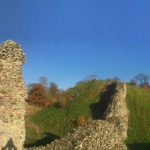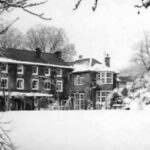Biography:
Richard Philip Cooper
26/07/1902 –22/08/1966
Richard Philip Cooper
 View full burial details
View full burial details
RICHARD PHILIP COOPER: 1902 – 1966
Richard, or Philip as he was usually known, was the second of three sons born to Richard Ashmole Cooper and his wife Alice Elizabeth Cooper, née Priestland. Richard and Alice had married in April 1900, and their first son, William Herbert Cooper, was born in 1901. He was followed by Philip in 1902 and Francis Ashmole Cooper in 1905. Richard and Alice lived at Whitehill in Berkhamsted, but later moved to Ashlyns Hall. From Ashlyn’s Hall the family moved to Felden Lodge, Boxmoor and for a short period in 1915 occupied Shenstone Hall in Lichfield where Philip’s grandparents had lived. In 1917 the family moved to Billington Manor near Leighton Buzzard[1].
In 1905, Philip’s grandfather, Richard Powell Cooper was made a baronet for services to agriculture. When he died in 1913 the title passed to Philip’s father, passing in turn to Philip’s older brother William Herbert on the death of their father in 1946.
Philip was educated at Malvern College until his health compelled him to leave and he had to finish his schooling privately. He went to Kings College, Cambridge in 1921. In 1924 he passed Part 1 of the Natural Sciences Tripos and took his degree. He then spent a fourth year reading Law and was called to the Inner Temple in 1929. He practised law for several years, but eventually became more interested in the family business.
Philip took up flying. He was granted his pilot’s licence by the London Aeroplane Club on 22nd June 1927 whilst he was still a law student. He eventually gave up powered flight to become a keen glider pilot, participating in a Lakes Gliding Club competition in 1938.[2]
He served in the cadet corps at Cambridge and from 1925 he served in 62 Field Brigade, Royal Artillery (TA) and was placed on Territorial Army Reserve in 1937 at the rank of Major. He spent time in a number of roles in the army when he was called up at the outbreak of WW2, including apparently a spell with the SAS.
Impressed by the success of German Airborne operations, the Allies decided to form their own airborne forces and as part of that drive, the Glider Pilot Regiment was formed to provide crews for military gliders. This was achieved by searching for members of the armed forces with pre-war experience of gliding; amongst their number was Philip.
There are two references to Philip in “Glider Pilots in Sicily.”[3] The first relates to a report given by Captain Philip Cooper, an artillery officer undergoing glider training, of the training accident that led to the death of the regiment’s first commanding officer in October 1942. The second places him in North Africa as a major in command of No. 1 Squadron. Airborne troops, including gliders, flew from North Africa as part of the invasion of Sicily. Philip was held in reserve and did not take part in those landings. It was probably fortunate for Philip that he was in reserve, as of the 144 gliders that made the journey to Sicily, 65 were released too early by the American towing aircraft and came down in the sea. Some 250 men were drowned. Philip also helped launch the glider assault at Arnhem, but he was not himself allowed to go into battle. He was invalided out of the Army in 1944.
After the war Philip was the chairman of the Glider Pilot Regimental Association.
On leaving the Army he joined the family firm again and studied to be a veterinary surgeon but his health failed before he could complete his studies. He became Personnel Director in the company. He retired from his directorship when the family company was acquired by the Wellcome Foundation in 1962.
In the early 1920s Philip met Kathleen, “Kitty,” Knight. The Knight family had made its money through the manufacture of soap. Kitty’s parents had moved to Kenya where they took up farming and whilst in Kenya, Kitty met Edward Andreas Priestland (known as Andreas) and the two became engaged to be married. Andreas was the brother of Philip’s mother Alice and before the wedding they travelled back to England and Kitty was introduced to Andreas’ family, including Alice and her sons. During her visit, Philip fell in love with Kitty, but could not say anything as she was engaged to his uncle.
Kitty and Andreas were married in Nairobi in 1922 and lived in Kenya, also on a farm, for just under four years before Andreas died in 1926 of a burst appendix, leaving Kitty with one small daughter and a baby girl on the way Unable to remain on the farm in Kenya, Lady Cooper arranged for Kitty to return to England where she settled in Berkhamsted and found her employment as a housekeeper for Philip.
In 1944 Philip married his cousin Eileen Frances Cooper. The marriage only lasted four years and Philip and Eileen were divorced in 1948.
Finally, after a few years, Philip summoned up the courage to propose to Kitty and they were married in 1951.
Philip died peacefully in hospital on 22 August 1966.
We are greatly obliged to Mark Evans, grandson of Kitty Cooper, who kindly provided much of the above information.
 View this burial
View this burial in the cemetery
RICHARD PHILIP COOPER: 1902 – 1966
Richard, or Philip as he was usually known, was the second of three sons born to Richard Ashmole Cooper and his wife Alice Elizabeth Cooper, née Priestland. Richard and Alice had married in April 1900, and their first son, William Herbert Cooper, was born in 1901. He was followed by Philip in 1902 and Francis Ashmole Cooper in 1905. Richard and Alice lived at Whitehill in Berkhamsted, but later moved to Ashlyns Hall. From Ashlyn’s Hall the family moved to Felden Lodge, Boxmoor and for a short period in 1915 occupied Shenstone Hall in Lichfield where Philip’s grandparents had lived. In 1917 the family moved to Billington Manor near Leighton Buzzard[1].
In 1905, Philip’s grandfather, Richard Powell Cooper was made a baronet for services to agriculture. When he died in 1913 the title passed to Philip’s father, passing in turn to Philip’s older brother William Herbert on the death of their father in 1946.
Philip was educated at Malvern College until his health compelled him to leave and he had to finish his schooling privately. He went to Kings College, Cambridge in 1921. In 1924 he passed Part 1 of the Natural Sciences Tripos and took his degree. He then spent a fourth year reading Law and was called to the Inner Temple in 1929. He practised law for several years, but eventually became more interested in the family business.
Philip took up flying. He was granted his pilot’s licence by the London Aeroplane Club on 22nd June 1927 whilst he was still a law student. He eventually gave up powered flight to become a keen glider pilot, participating in a Lakes Gliding Club competition in 1938.[2]
He served in the cadet corps at Cambridge and from 1925 he served in 62 Field Brigade, Royal Artillery (TA) and was placed on Territorial Army Reserve in 1937 at the rank of Major. He spent time in a number of roles in the army when he was called up at the outbreak of WW2, including apparently a spell with the SAS.
Impressed by the success of German Airborne operations, the Allies decided to form their own airborne forces and as part of that drive, the Glider Pilot Regiment was formed to provide crews for military gliders. This was achieved by searching for members of the armed forces with pre-war experience of gliding; amongst their number was Philip.
There are two references to Philip in “Glider Pilots in Sicily.”[3] The first relates to a report given by Captain Philip Cooper, an artillery officer undergoing glider training, of the training accident that led to the death of the regiment’s first commanding officer in October 1942. The second places him in North Africa as a major in command of No. 1 Squadron. Airborne troops, including gliders, flew from North Africa as part of the invasion of Sicily. Philip was held in reserve and did not take part in those landings. It was probably fortunate for Philip that he was in reserve, as of the 144 gliders that made the journey to Sicily, 65 were released too early by the American towing aircraft and came down in the sea. Some 250 men were drowned. Philip also helped launch the glider assault at Arnhem, but he was not himself allowed to go into battle. He was invalided out of the Army in 1944.
After the war Philip was the chairman of the Glider Pilot Regimental Association.
On leaving the Army he joined the family firm again and studied to be a veterinary surgeon but his health failed before he could complete his studies. He became Personnel Director in the company. He retired from his directorship when the family company was acquired by the Wellcome Foundation in 1962.
In the early 1920s Philip met Kathleen, “Kitty,” Knight. The Knight family had made its money through the manufacture of soap. Kitty’s parents had moved to Kenya where they took up farming and whilst in Kenya, Kitty met Edward Andreas Priestland (known as Andreas) and the two became engaged to be married. Andreas was the brother of Philip’s mother Alice and before the wedding they travelled back to England and Kitty was introduced to Andreas’ family, including Alice and her sons. During her visit, Philip fell in love with Kitty, but could not say anything as she was engaged to his uncle.
Kitty and Andreas were married in Nairobi in 1922 and lived in Kenya, also on a farm, for just under four years before Andreas died in 1926 of a burst appendix, leaving Kitty with one small daughter and a baby girl on the way Unable to remain on the farm in Kenya, Lady Cooper arranged for Kitty to return to England where she settled in Berkhamsted and found her employment as a housekeeper for Philip.
In 1944 Philip married his cousin Eileen Frances Cooper. The marriage only lasted four years and Philip and Eileen were divorced in 1948.
Finally, after a few years, Philip summoned up the courage to propose to Kitty and they were married in 1951.
Philip died peacefully in hospital on 22 August 1966.
We are greatly obliged to Mark Evans, grandson of Kitty Cooper, who kindly provided much of the above information.
Relatives
Historical Connections
The following local places of interest are linked to Richard Philip Cooper:





 Coopers Chemical Works
Coopers Chemical Works Berkhamsted Castle
Berkhamsted Castle Ashlyns Hall
Ashlyns Hall Sunnyside Church
Sunnyside Church White Hill
White Hill
 Military graves
Military graves